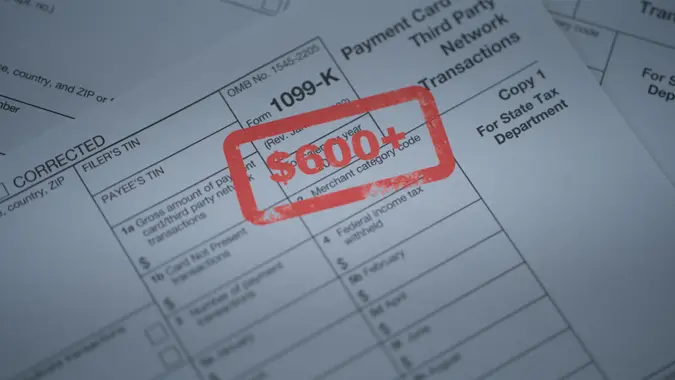If You Use PayPal or Other Third-Party Apps for Your Business, Be Aware of This Tax Change

Commitment to Our Readers
GOBankingRates' editorial team is committed to bringing you unbiased reviews and information. We use data-driven methodologies to evaluate financial products and services - our reviews and ratings are not influenced by advertisers. You can read more about our editorial guidelines and our products and services review methodology.

20 Years
Helping You Live Richer

Reviewed
by Experts

Trusted by
Millions of Readers
If you’re a freelancer, side hustler or business owner who gets paid via PayPal or Venmo for your services, expect big changes this tax season. Third-party payment apps are now required to send you and the IRS a 1099-K form that reports $5,000 or more of income. Here’s everything to know.
What Is a 1099-K Form
Income made from selling goods, rental property or services and paid through a third-party payment app must be reported. According to the IRS, the 1099-K form will show the payments received to ensure taxpayers pay the correct amount of taxes. If you received $5,000 or more from different apps, you will receive multiple 1099-K forms.
Per the IRS, the following platforms can send 1099-K forms:
- Online community marketplace
- Craft or maker marketplace like Etsy
- Auction site
- Car-sharing or ride-hailing platforms like Lyft and Uber
- Ticket exchange or resale site like StubHub or Ticketmaster
- Crowdfunding platform
- Freelance marketplace
- Payment App
The $600 Rule
In 2021, Congress switched things up and created the American Rescue Plan Act (ARPA), according to the National Taxpayers Union Foundation.
Before ARPA, taxpayers had to report third-party app payments of $20,000. However, ARPA cut the threshold to $600 with no minimum number of transactions.
The new rule was supposed to take place in 2022, but the initiative was delayed because it was challenging to distinguish between taxable and nontaxable payments.
“We spent many months gathering feedback from third-party groups and others, and it became increasingly clear we need additional time to effectively implement the new reporting requirements,” said IRS Commissioner Danny Werfel in a 2023 IRS statement.
The Rollout Phase
Over the next three years, the plan will be implemented in stages and taxpayers will see the following changes:
- 2024 tax year: Anyone who received $5,000 or more on a third-party payment app will get a 1099-K form, per the IRS.
- 2025 tax year: The threshold drops to $2,500,
- 2026 tax year: The amount decreases to $600.
The 1099-K rule only applies to income received from a third-party payment app.
Personal Payments
Personal payments from third-party payment apps from friends and family are not taxable, according to the IRS. The following are examples of what is not counted towards the income threshold.
- Splitting the cost of meals or ride-share costs
- Birthday and holiday cash gifts
- Repayment of rent or a household bill from a roommate
To avoid confusion, the IRS recommends labeling these transactions as “non-business” in payment apps.
Don’t Double Report Income
Like with anything, new rules in the beginning can be confusing, so be careful not to double-report your income. For example, if you earned $12,000 on a freelance project, you’ll likely receive a 1099 form from the company or person who hired you. If you were paid for the project through a third-party payment app, you will receive a 1099-K form for the same earnings. You don’t need to report both, as reported by CNET.
The new law is likely to shock many, but Mark Steber, chief tax information officer for Jackson Hewitt, told CNBC, “A lot of people think this change is some new tax grab and that someone is trying to get the little guy. The reality is, if you’ve had self-employment or side-gig income, that’s had to go on your tax return since 1913.”
For questions or concerns, speak to a professional tax expert regarding a 1099-K form and how to file.
 Written by
Written by  Edited by
Edited by 

























